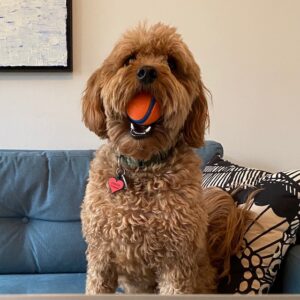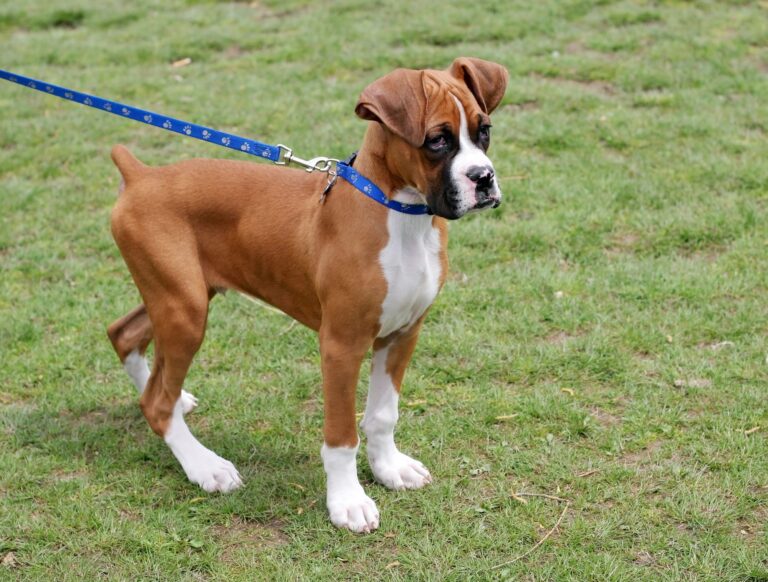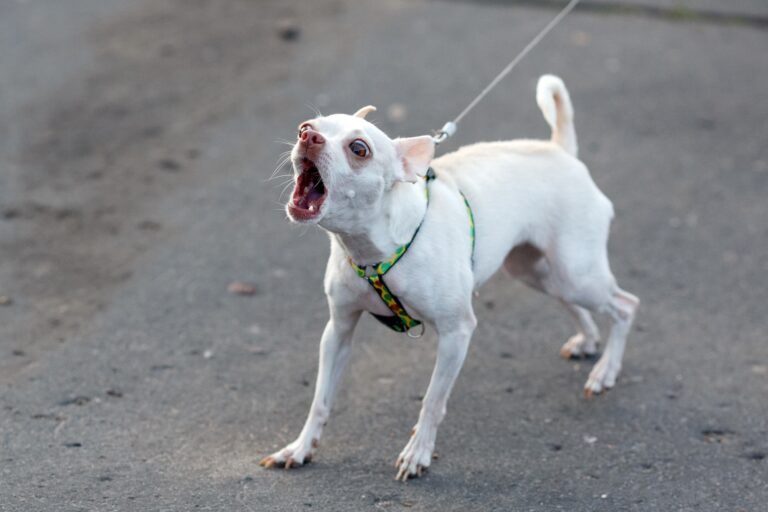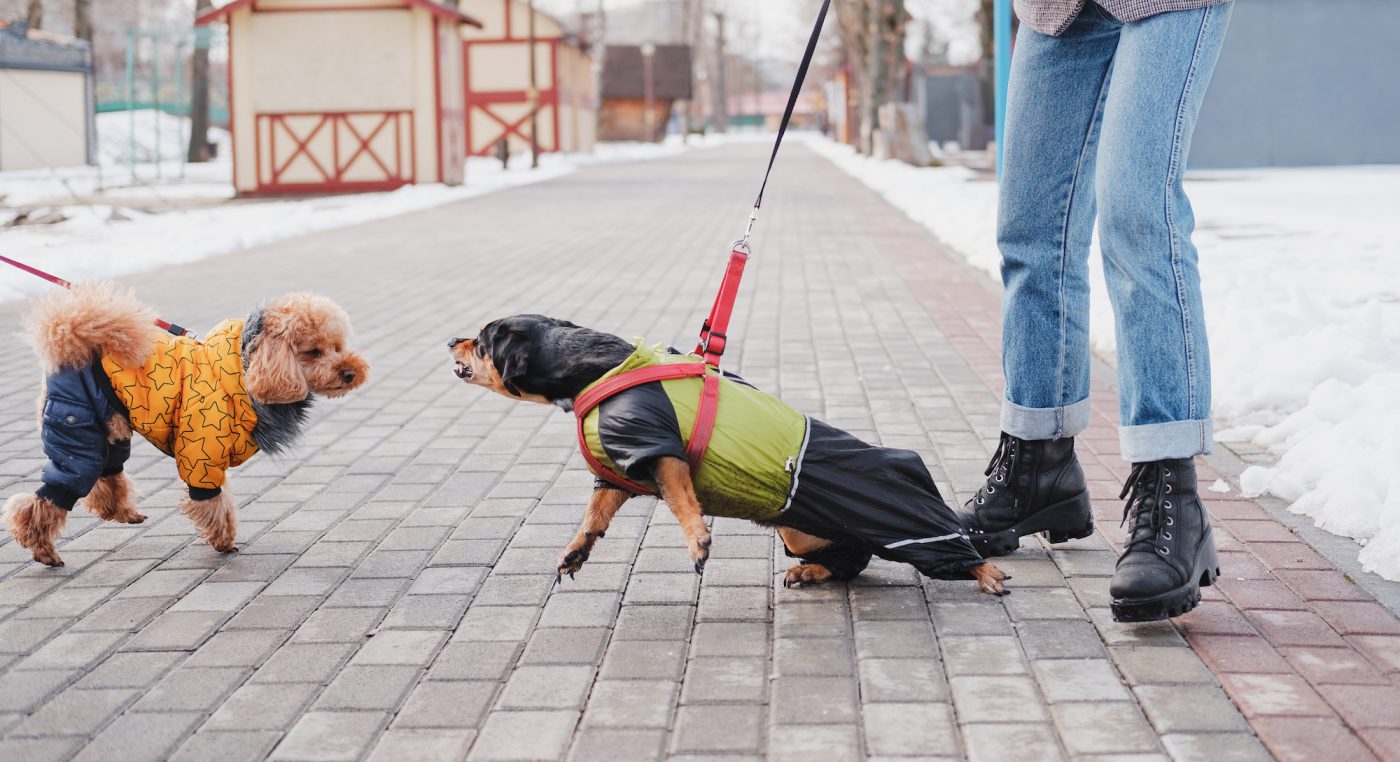For the first few years of his life, my wife and I called our dog Omar “The Rug” because he would lie down when other dogs approached and couldn’t wait to greet and play with them.
His submissiveness and sweet behavior made it a joy to walk him around our dog-filled New York City neighborhood. Every walk was one adorable encounter after another, and we met other dog owners who, like us, were charmed by Omar’s delightful behavior.
But a few years ago, our now-seven-year-old mini goldendoodle started showing signs of leash reactivity while he was being walked. As the term implies, reactive dogs react to certain stimuli, and they may growl, bark and lunge toward the cause of their distress.
Some dogs are triggered by skateboarders, or people getting too close to them. Others lose it when they see another dog approaching—that was Omar’s issue. Omar didn’t go full-on Cujo. But he started barking at other dogs—more specifically, big dogs with pointy ears (think German shepherds and huskies). Frankly, it got to the point where his outbursts were becoming embarrassing. We felt like the worst dog moms in the world.

Omar. Seems harmless enough…
“It is sort of embarrassing to be out in public and feel like your dog is misbehaving,” says Kate Senisi, certified professional dog trainer and director of training and behavior and co-founder of School For The Dogs in New York City.
But she also points out that it’s a common problem, and your dog isn’t simply being a jerk. “There’s an underlying emotional component to it,” she says. This motivation could be anything from fear to frustration. While it can be difficult to get to the root of the reaction, determining its cause can help you address the problem. If you’re not sure, or haven’t observed any directly contributing incidents, working with a trainer can help determine the nature of the reactivity, and, relatedly, what solution can work best.
Here are some of the steps we took that helped restore Omar’s (natural) sweet sidewalk demeanor.
Prevent bad habits before they become habits
While we may never know why Omar has an aversion to big dogs with pointy ears, it’s best to nip any dog’s reactive behavior in the bud. “The more that the animal is rehearsing that undesirable behavior, the stronger it’s going to get,” says Senisi. “It’s just like habits with humans. The more we repeat a habit, the more likely we are to do that habit. It’s sort of like the better we get at it. So if you can catch any inkling of it at the beginning or early on, that’s the best time to get hold of it.”
This can be tough on a busy city sidewalk, but try to reduce the opportunity your dog has to “practice” the offending behavior. Avoid close confrontations when possible while you work on leash skills.
We have had Omar since he was a puppy. What if you have adopted a dog who is older and who exhibits reactive behavior while being walked? Is it too late? “It’s definitely harder to work with a dog that’s been rehearsing behaviors like that for several years,” Senisi says, but it’s possible to learn some management techniques and figure out how to lessen the intensity and frequency of the reactions.

Fixated
Learn the signals to prevent the reaction
Eighty percent of addressing leash reactivity is teaching the human how to observe the dog’s body language and move them away before they’ve tipped over into reactivity, Senisi says.
One major sign that your dog is about to go into reactivity mode: staring. “If a dog is staring at something, and you call their name, and they’re not able to disengage, that means they’re getting close to that zone,” she says.
Other signs include shifting far forward on the leash, or backing away from something. In our case, we began to notice that Omar’s body would stiffen and he would give side-eye. It actually took us a while to become aware of these warning signs because they were so subtle.
Teach an alternative behavior
Being in tune with the warning signs allows you the opportunity to distract your dog, and to pull their focus away from the trigger so they don’t get stuck on it. The idea is to teach an alternative behavior to reacting, says Senisi.
Getting your dog to make eye contact with you is one alternative behavior. While walking, position your dog close enough that they see the triggering dog or object, but not close enough that they’re in full reaction mode, or over threshold (if they won’t focus on you, even with a treat, you’re too close). Have your dog look at you, mark the action with a word or phrase, and immediately give them a reward. Continue this process and over time you can close that distance, being careful not to progress too far, too fast.
“It’s about building trust and focus, building a rapport,” Senisi says. “You are showing your dog, ‘I’ve got this. You can check in with me. I’m not going to move you closer to the dog until you’re ready, and you don’t have to stare.’”
While every dog responds to different rewards, food often does the trick. “If you are using food, it has to be something that’s high enough value to the dog, especially for this issue. It’s got to be something where the dog is like, ‘You know what? I am getting the urge to react, but I know my mom’s got this amazing treat.’ ” As you reward your dog for calmly looking at you, or performing another desired behavior instead of going bananas, you’re creating a new, positive association with the triggering object.

If possible, work with a trainer
All of this sounds straightforward, right?
But leash reactivity can be a stubborn issue that requires a lot of patience and practice to deal with, which is why it really helps to either take a group class or arrange individual training sessions with a professional trainer.
A trainer can help you identify the source of the behavior, and whether your dog is frustrated, fearful or aggressive, and adapt their methods accordingly.
Contacting a recommended, certified professional dog trainer is a good start if it’s available to you. “A lot of people feel really overwhelmed, and they’re not even sure where to start,” says Senisi, who teaches a group class for reactive dogs called Sidewalk Psychos.
Even if you can only swing one consultation with a trainer, Senisi says, “there are some skills that even in a first session you could start to learn that will probably vastly improve your walks.”
Omar, my wife and I took Senisi’s eight-week Sidewalk Psychos class a few years ago, and it made all the difference. We learned leash-walking techniques, how to use a marker word to reward Omar for looking at us, how to get Omar to relax around other dogs, and, as noted above, how to read Omar’s body language.
Once we learned how to handle his leash reactivity, it became a joy to walk Omar again. Yes, every once in a while, he will catch one of us—usually me—off guard and bark at another dog. But that’s rare because we tend to step right in to prevent him from reacting by telling him, “Look at me” and rewarding him with food. At first, we used high-value treats like cheese, but Omar now happily accepts training treats.
Omar’s behavior has improved because we have consistently prevented him from reacting to other dogs. Unchecked, he would regress back to his peak reactivity pretty quickly.
All this to say, we will never stop training Omar.
“One of the challenges that’s hard to overcome is helping clients understand that their dog is always training,” Senisi stresses. “So whether or not the human is like, ‘I’m in training mode,’ the dog is always learning something.”









